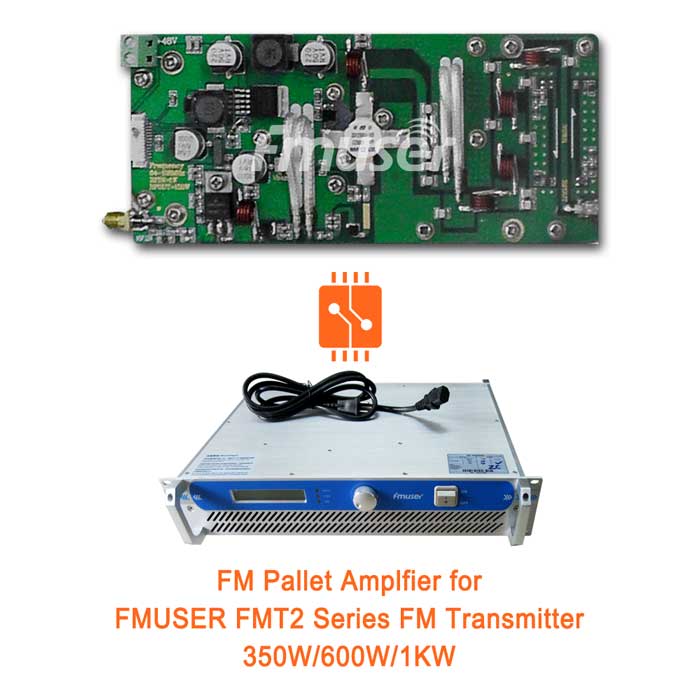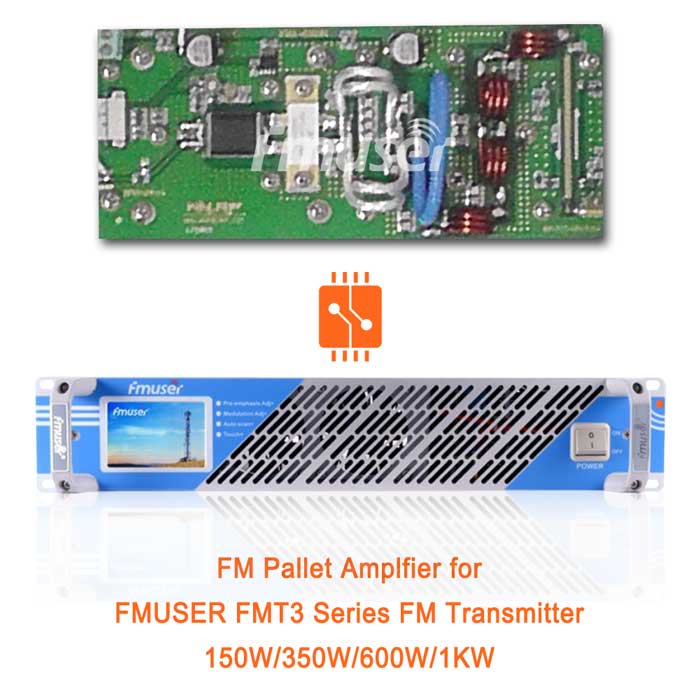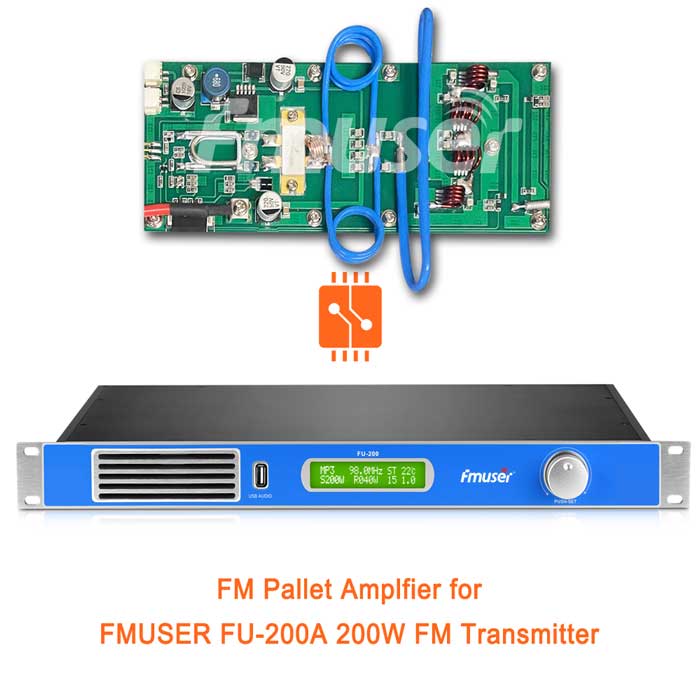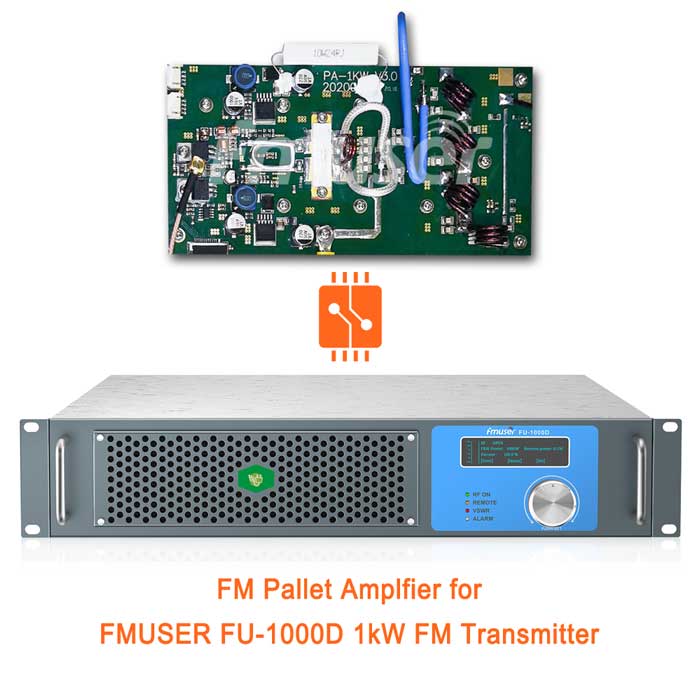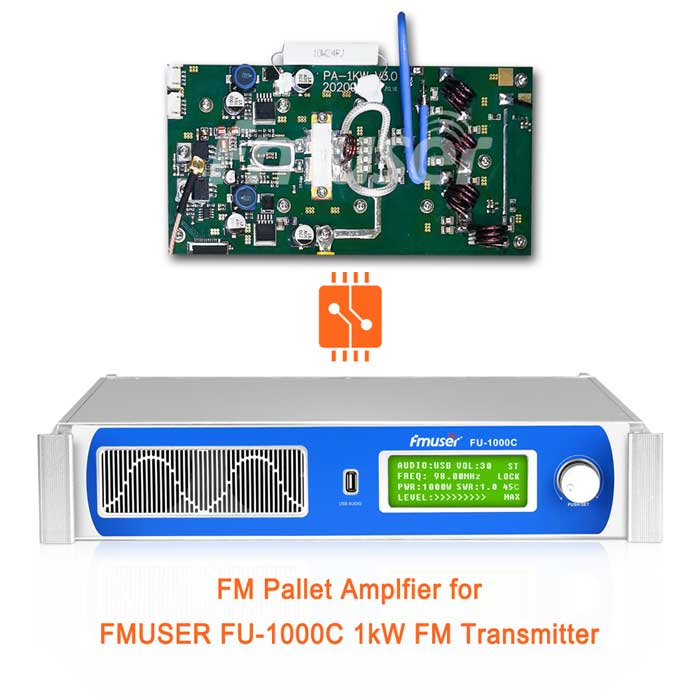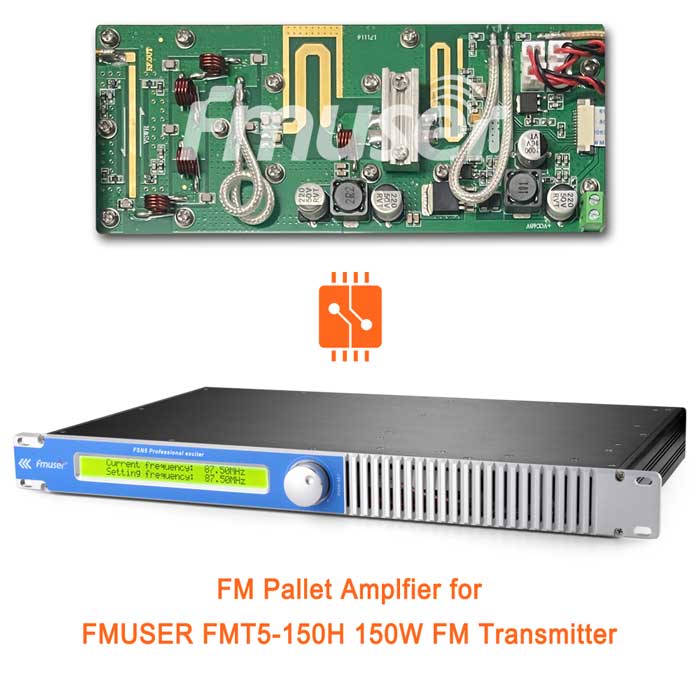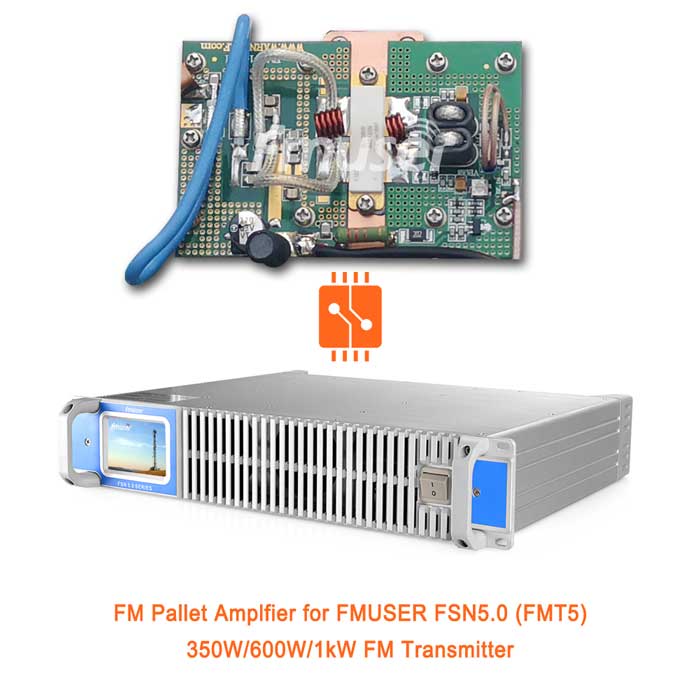
FM Transmitter Amplifiers
FM pallet amplifiers are critical solutions for modern broadcast and RF transmission needs, ensuring reliable signal distribution across industries like radio, telecommunications, and emergency communication systems.
1. Power Up Your Signal: Discover FMUSER’s FM Pallet Amplifiers for Unmatched Broadcasting
At FMUSER, we specialize in RF engineering excellence, offering a curated range of pallet amplifiers categorized by power output (50W to 10kW+), frequency range (87.5–108 MHz or custom), and application specificity (indoor/outdoor, fixed/mobile). This systematic classification simplifies selection for professionals targeting low-latency, high-fidelity broadcasting, whether for small community stations or large-scale network deployments.
2. Engineered to Deliver: Why FMUSER’s Amplifiers Outperform the Rest
- Military-Grade Durability: Rugged design for 24/7 operation in extreme temperatures (-30°C to 60°C).
- Certified Efficiency: CE/FCC compliance with 80%+ energy efficiency to reduce costs.
- Smart Protection: Built-in surge protection, overheating alerts, and adaptive cooling.
- Scalable Architecture: From entry-level 50W models for hobbyists to 10kW+ industrial-grade systems for broadcast networks.
- Advanced Integration: Support for DSP controls, remote monitoring, and seamless compatibility with exciters/transmitters.
3. Amplify Every Signal: Industry-Specific Solutions Built for Success
- 📻 Community Radio Stations: Affordable, low-power amplifiers (50W–500W) ensure crystal-clear signal reach for local broadcasts. FMUSER’s pre-configured packages enable quick deployment.
- 🚨 Emergency Broadcast Systems: High-power, fault-tolerant amplifiers (1kW–10kW) guarantee uninterrupted communication during crises. Our IP65-rated models withstand harsh environments.
- 📡 Commercial Broadcasting Networks: Multi-stage amplifiers deliver stable signals across wide frequencies. FMUSER’s modular designs allow easy upgrades as networks expand.
- 🎤 Live Event Broadcasting: Portable 300W–2kW amplifiers with ultra-low distortion ensure professional audio quality for concerts, sports events, and outdoor festivals.
4. Why FMUSER? Your Turnkey Partner in RF Excellence
- Factory Direct Savings: Enjoy 30% lower prices with no middlemen. Always in-stock units ship in 72 hours globally.
- All-in-One Solutions: Full packages include amplifiers, antennas, cabling, and installation guides.
- White-Glove Services: Free pre-configuration, on-site support (optional), and 3-year warranty.
- Customization Ready: OEM/ODM orders accepted with tailored specs (voltage, connectors, software).
- Proven Expertise: Trusted by broadcasters in North America, Southeast Asia, Africa, and Europe.
5. Your Perfect Amplifier Awaits: A Quick Buyer’s Checklist
- Match Power Needs: Ensure output aligns with coverage area (e.g., 500W for 15–20 km radius).
- Verify Frequency: Confirm compatibility with local FM bands (87.5–108 MHz standard).
- Budget Smartly: Balance upfront cost vs. lifetime value (FMUSER’s energy-saving models cut OPEX by 25%).
- Plan for Growth: Opt for modular systems if expanding later.
-
![FMUSER FMT2 FM TX Series 350W/600W/1KW FM Broadcast Power Amplifier]()
FMUSER FMT2 FM TX Series 350W/600W/1KW FM Broadcast Power Amplifier
Price(USD):Ask for a quotation
Sold:11
-
![FMUSER FMT3 150W/350W/600W/1KW FM Transmitter Power Amplifier]()
FMUSER FMT3 150W/350W/600W/1KW FM Transmitter Power Amplifier
Price(USD):Ask for a quotation
Sold:11
-
![FMUSER 200 Watt FM Broadcast Amplifier for FU-200A 200W FM Transmitter]()
FMUSER 200 Watt FM Broadcast Amplifier for FU-200A 200W FM Transmitter
Price(USD):Ask for a quotation
Sold:13
-
![FMUSER Premium 1000W FM Broadcast Transmitter Amplifier Module for FU-1000D]()
FMUSER Premium 1000W FM Broadcast Transmitter Amplifier Module for FU-1000D
Price(USD):Ask for a quotation
Sold:4
-
![FMUSER 1000W FM Pallet Amplifier Module for FU-1000C 1kW FM Transmitter]()
FMUSER 1000W FM Pallet Amplifier Module for FU-1000C 1kW FM Transmitter
Price(USD):Ask for a quotation
Sold:13
-
![FMUSER FMT5-150H Complete 150 Watt FM Broadcast Amplifier Module]()
FMUSER FMT5-150H Complete 150 Watt FM Broadcast Amplifier Module
Price(USD):Ask for a quotation
Sold:25
-
![FMUSER FSN5.0&FMT5 FM TX 350W/600W/1000W Pallet FM Amplifier Kit]()
FMUSER FSN5.0&FMT5 FM TX 350W/600W/1000W Pallet FM Amplifier Kit
Price(USD):Ask for a quotation
Sold:6
- What are the structures of a FM transmitter amplifier?
- An FM transmitter amplifier may have different structures depending on its design and specifications. However, the basic components of a typical FM transmitter amplifier include the following:
1. Input circuit: This is a circuit that receives the low-power FM signal from the source, such as a microphone or audio device, and conditions it for amplification. It may include filters, impedance matching networks, and preamplifiers to optimize the signal quality and impedance matching.
2. RF amplifier stages: These are circuits that amplify the conditioned signal to higher power levels. They may be composed of single or multiple stages of amplification, depending on the output power requirements. The amplification stages may use different amplifier technologies such as bipolar transistors, FETs, or MOSFETs.
3. Power supply: The FM transmitter amplifier requires a power supply to provide the necessary voltages and currents for the amplification stages. The power supply may be a regulated or unregulated voltage source, depending on the desired output power and stability.
4. Low-pass filter: After the RF amplification stages, the amplified signal is typically passed through a low-pass filter to remove any harmonics or spurious signals generated by the amplification process. This filter ensures that the output signal complies with the FCC regulations for FM broadcasting.
5. Output circuit: The output circuit receives the amplified and filtered signal and may include impedance matching networks, output filters, and RF connectors for coupling the signal to the antenna.
Overall, the structure of an FM transmitter amplifier is designed to ensure that the FM signal is amplified efficiently and effectively, while complying with the regulations for FM broadcasting.
- What else componets are there inside an FM transmitter except for the amplfier?
- An FM transmitter typically consists of several components besides the FM transmitter amplifier. These components work together to generate, modulate, and transmit an FM signal. Some of the common components inside an FM transmitter are:
1. Oscillator: This is a circuit that generates a high-frequency sinusoidal signal. In an FM transmitter, the oscillator typically operates at a frequency within the FM broadcast band (88-108MHz).
2. Modulator: This circuit modulates the high-frequency signal generated by the oscillator with the audio or data signal that carries the information to be transmitted. The most common modulation technique used in FM broadcasting is frequency modulation (FM).
3. Frequency multiplier: This circuit increases the frequency of the oscillator signal to the required output frequency. In an FM transmitter, the frequency multiplier typically uses a frequency synthesizer or a frequency multiplier circuit to achieve the desired output frequency within the FM broadcast band.
4. Audio processing: This is a set of circuits that processes the audio signal before it is modulated onto the carrier wave. Audio processing can include filtering, equalization, compression, and limiting.
- Output circuit: The output circuit receives the amplified and filtered signal and may include impedance matching networks, output filters, and RF connectors for coupling the signal to the antenna.
- Low-pass filter: After the RF amplification stages, the amplified signal is typically passed through a low-pass filter to remove any harmonics or spurious signals generated by the amplification process. This filter ensures that the output signal complies with the FCC regulations for FM broadcasting.
5. Power amplifier: This circuit amplifies the modulated, high-frequency signal to increase its power level. The power amplifier stage is usually followed by a low-pass filter to remove any unwanted harmonics, and then connected to an antenna to radiate the signal into the atmosphere.
6. Control circuits: These are the circuits that manage and control the signals and components within the FM transmitter. They may include circuits for frequency locking, power control, and monitoring.
- Power supply: The FM transmitter amplifier requires a power supply to provide the necessary voltages and currents for the amplification stages. The power supply may be a regulated or unregulated voltage source, depending on the desired output power and stability.
- RF amplifier stages: These are circuits that amplify the conditioned signal to higher power levels. They may be composed of single or multiple stages of amplification, depending on the output power requirements. The amplification stages may use different amplifier technologies such as bipolar transistors, FETs, or MOSFETs.
- Input circuit: This is a circuit that receives the low-power FM signal from the source, such as a microphone or audio device, and conditions it for amplification. It may include filters, impedance matching networks, and preamplifiers to optimize the signal quality and impedance matching.
All these components work together to produce and broadcast an FM signal that carries audio or data information. The oscillator generates the high-frequency carrier wave, the modulator adds the audio information to the carrier, and the amplifier increases the power of the signal, while the control circuits ensure proper operation and compliance with regulations.
- Does FM transmitter amplifier equals to RF amplifier and why?
- The FM transmitter amplifier is a specific type of RF amplifier designed to increase the power of the FM signal generated by the FM transmitter. Therefore, technically speaking, the FM transmitter amplifier can be considered a type of RF amplifier as it amplifies an RF (radio frequency) signal. However, not all RF amplifiers are FM transmitter amplifiers.
RF amplifiers can be used for various radio frequency applications, including amplification of TV signals, satellite signals, and wireless communication signals. The FM transmitter amplifier is specifically designed for amplifying the FM signal within the frequency range of 88-108MHz, which is the FM broadcast band. Its output is tailored to comply with relevant regulatory requirements for FM broadcasting.
So, while FM transmitter amplifier is a type of RF amplifier, not all RF amplifiers are suitable or optimized for use as a FM transmitter amplifier. The FM transmitter amplifier is designed specifically to meet the requirements of FM broadcasting and ensure high-quality and reliable transmission of FM signals.
- Does FM transmitter amplifiers vary from transmitter of different power level?
- The FM transmitter amplifier used in FM transmitters with different power levels can differ in several aspects, such as configuration, prices, performance, size, installation, vulnerability, repairment, maintenance, etc. Here are some possible differences:
1. Configuration: Higher-power FM transmitter amplifiers require additional amplification stages, higher voltage power supplies, and more robust input/output filters, compared to lower-power amplifiers. This often results in a more complex amplifier configuration, which may require more specialized design and assembly techniques.
2. Prices: The cost of FM transmitter amplifiers can vary significantly depending on their power rating, quality, and manufacturer. Generally, higher-power amplifier modules are more expensive than lower-power modules due to higher component costs, greater power handling requirements, and more rigorous testing.
3. Performance: High-power FM transmitter amplifiers generally offer improved linearity, efficiency, and distortion performance, which can lead to higher signal quality and better coverage range. However, the actual performance may also depend on the quality of other components in the transmitter such as oscillator, modulator, and input/output filters.
4. Size: The physical size of FM transmitter amplifiers is usually proportional to their power rating. Higher-power amplifiers require larger heatsinks, more substantial casings, and larger input/output connectors, which can result in a larger overall size and weight.
5. Installation: The installation of FM transmitter amplifiers can be more complex for higher-power models due to their larger size, higher power requirements, and higher voltage levels. They may require more robust installation hardware, specialized tools, and skilled technicians for proper installation.
6. Vulnerability: Higher-power FM transmitter amplifiers can be more prone to damage from overheating, power surges, lightning strikes, or other electrical disturbances. This requires additional measures to protect the amplifier and ensure its longevity.
7. Repairment and Maintenance: Repairment and maintenance of higher-power FM transmitter amplifiers can be more challenging and expensive than lower-power models due to their complexity and specialized components. They may require more skilled technicians, special equipment, and longer repair times resulting in higher maintenance costs.
In summary, higher-power FM transmitter amplifiers tend to be more complex, larger, more expensive, and require more expertise for their installation, maintenance, and repairment. However, they can also offer better performance, wider coverage range, and improved reliability compared to lower-power models. Ultimately, the choice of FM transmitter amplifier should be based on the intended power level, operational requirements, and available budget.
- What may lead to the burn-out of an FM transmitter amplifier?
- FM transmitter amplifiers can be damaged due to several reasons, including:
1. Overdriving the input signal: Applying too much input power to the amplifier can cause it to saturate, resulting in distorted output signals that could damage the amplifier. To avoid this, it is essential to ensure that the input power level is within the recommended range.
2. High-temperature operation: Operating the amplifier at high temperatures for extended periods can cause the heat-sensitive components (such as transistors) to degrade, leading to reduced performance and eventual burnout. It is important to keep the amplifier temperature under control by using adequate ventilation, heat sinks, and temperature controls.
3. Voltage spikes or surges: FM transmitter amplifiers can be damaged due to voltage spikes or surges in the power supply or input signal. This can be avoided by using surge protectors, voltage regulators, and other protective devices.
4. Incorrect impedance matching: Mismatching the output impedance of the amplifier with the load impedance (typically the antenna) can cause high levels of reflected power, leading to overheating and damage to the amplifier. It is essential to ensure proper impedance matching by using the correct output filter and load impedance.
5. Improper handling during installation: Careless handling during installation can cause mechanical stress on the amplifier, damaging its components and resulting in performance degradation and eventual burnout. It is essential to follow the manufacturer's installation instructions and handle the amplifier with care.
To avoid these situations and prevent burnout of the FM transmitter amplifier, it is recommended to follow the manufacturer's instructions and guidelines for installation, operation, and maintenance. Keep the amplifier temperature under control, use adequate protective devices, and ensure proper impedance matching. It is also essential to operate the amplifier within the recommended operational limits and avoid inappropriate manual operating such as excessive input voltage, incorrect impedance matching or modifications, or tampering with the internal components of the amplifier.
- How to correctly use and maintain an FM transmitter amplifier?
- Correct usage and proper maintenance practices can help to increase the life expectancy of an FM broadcast transmitter and its associated amplifier. Here are some tips to consider:
1. Follow the manufacturer's instructions: Always follow the operating and maintenance instructions provided by the manufacturer, including recommended power levels, operational limits, and maintenance intervals.
2. Ensure proper ventilation and temperature control: FM transmitter amplifiers generate a lot of heat, so it’s important to ensure adequate ventilation and temperature control. Keep the amplifier cabinet clean and free of any obstructions that may hinder airflow and cause heat buildup. Use adequate cooling fans, heat sinks, and temperature control devices to keep the amplifier within acceptable temperature limits.
3. Use high-quality components: Choose high-quality components for your FM transmitter, including the amplifier module, input/output filters, and other critical components. This can help to ensure better performance and decrease the risk of premature failure.
4. Protect against power surges and lightning strikes: Install surge protectors, voltage regulators, and lightning arrestors to protect the amplifier against power surges and lightning strikes.
5. Perform regular maintenance: Perform regular preventive maintenance, including cleaning, inspection, and replacement of any worn or damaged parts. This can help to ensure that components are in good condition and operating at their optimal performance levels.
6. Don't exceed the recommended power levels: Never exceed the recommended power levels specified by the manufacturer for the amplifier, as this can cause damage to the amplifier and other components in the transmitter.
7. Monitor for signs of failure: Keep an eye out for any unusual sounds, smells, or performance issues that may indicate a problem with the amplifier. If you notice any issues, immediately stop using the transmitter and have it inspected by a qualified technician.
By following these tips, you can ensure that your FM broadcast transmitter and associated amplifier operate reliably and at optimal levels over its expected lifespan.
- How to repair an FM transmitter amplifier if it fails working?
- Repairing an FM transmitter amplifier requires a good understanding of the amplifier's internal components and circuitry, as well as expertise in troubleshooting electronic circuits. Here are the general steps involved in repairing an FM transmitter amplifier:
1. Identify the problem: Before attempting any repairs, identify the problem with the amplifier. This may involve testing the amplifier's components, checking for signs of physical damage, or using diagnostic tools to identify the problem area.
2. Obtain the necessary components: Once you’ve identified the problem, obtain the necessary components to replace any defective parts in the amplifier.
3. Disconnect power: Before repairing the amplifier, turn off and disconnect power from the amplifier to prevent electrical shock.
4. Open the amplifier casing: Open the amplifier casing and carefully examine the internal components for any signs of physical damage or corrosion.
5. Replace defective components: Replace any defective components or damaged parts found in the amplifier.
6. Reassemble the amplifier: Reassemble the amplifier, taking care to route cables and wires correctly and secure components in their proper locations.
7. Test the amplifier: Turn on the amplifier and test its performance to ensure that the problem has been resolved.
It is important to note that repairing a high-power FM transmitter amplifier can be dangerous and should only be done by experienced technicians. It is essential to take proper safety precautions, such as wearing protective equipment and using proper tools, when working with electronic circuits. If you are not confident in repairing the FM transmitter amplifier, consider consulting a qualified technician or contacting the manufacturer for repair services.
- How many types of FM transmitter amplifier are there?
- There are several types of FM transmitter amplifiers, categorized based on their power levels, size, and technology. Here's a look at some of the most common types of FM transmitter amplifiers:
1. Low-power FM transmitter amplifiers: Low-power amplifiers are typically used in small-scale FM radio stations, neighborhood radio stations, or hobbyist applications. They typically have an output power level of less than 100 watts and are often integrated with other transmitter components in a compact design.
2. Medium-power FM transmitter amplifiers: Medium-power amplifiers are found in community radio stations, religious radio stations, and small commercial stations. They typically have an output power level of 100-3000 watts and are often housed in rack-mounted enclosures.
3. High-power FM transmitter amplifiers: High-power amplifiers are used in commercial FM radio stations and broadcast networks. They typically have an output power level of up to 80 kW and require a dedicated amplifier building or separate cabinet for cooling, filtering, and other support equipment.
4. Solid-state FM transmitter amplifiers: Solid-state amplifiers use modern, high-efficiency transistor technology to provide reliable, efficient amplification. They are often preferred over vacuum-tube amplifiers due to lower maintenance requirements, better efficiency, and improved performance.
5. Tube-based FM transmitter amplifiers: Tube-based amplifiers use vacuum tubes (also known as valves) to provide amplification. While they require more maintenance and produce more heat, they are preferred by some radio operators due to their warmer sound and classic appeal.
6. Modular FM transmitter amplifiers: Modular amplifiers come in different sizes and power levels and are designed to be easily replaced or upgraded, making them ideal for facilities with changing power requirements or planning progressive upgrades.
It is important to note that the specific characteristics of each type of FM transmitter amplifier can vary based on the manufacturer and other specifications. Understanding the differences between these types of amplifiers can help you make an informed decision when choosing the appropriate amplifier for your specific application.
- Can I use FM transmitter amplifiers for transmitter of different brands?
- It is not recommended to use a brand A's FM transmitter amplifier with a brand B's FM transmitter, as it may not be compatible and could result in damage to the equipment. This is because different manufacturers may use different designs, standards, and specifications for their FM transmitter amplifiers and transmitters, which may not be compatible with each other.
Using an incompatible amplifier with a transmitter could result in poor audio quality, interference, or other performance issues. Moreover, it could cause damage to the amplifier, transmitter, or both, which may result in expensive repairs or replacement costs.
It is important to use components designed and manufactured by the same manufacturer as they are made to work together and have been tested for compatibility. When upgrading components in an existing system, it is essential to ensure that they are compatible with the existing system components to ensure optimal performance and avoid system failures.
- How to recognize if an FM transmitter amplifier is of high quality?
- There are several factors that can be used to determine if an FM transmitter amplifier is of high quality:
1. Output power level: High-quality FM transmitter amplifiers are capable of producing reliable and stable output power levels over time, without significant degradation or fluctuations.
2. Efficiency: High-quality FM transmitter amplifiers are efficient in converting input power to output power, reducing the amount of wasted power and lowering operating costs.
3. Signal integrity: High-quality FM transmitter amplifiers produce clean, stable, and distortion-free signals that meet FCC regulations and industry standards.
4. Durability and reliability: High-quality FM transmitter amplifiers are built with high-quality components and materials, capable of withstanding harsh environments and years of continuous use.
5. Advanced features: High-quality FM transmitter amplifiers may include advanced features such as automatic gain control, temperature and power protection, and remote control capabilities.
6. Warranty and support: High-quality FM transmitter amplifiers are often backed by a manufacturer's warranty and excellent customer support, which ensures that any issues can be quickly resolved.
It is essential to research and compare different brands and models of FM transmitter amplifiers to determine which ones are of the highest quality. Additionally, reading reviews from other users and consulting with industry experts can help in determining the quality of FM transmitter amplifiers.
- Why a high quality FM transmitter amplifier is important?
- A high-quality FM transmitter amplifier is important for broadcasting because it delivers clean, stable, and powerful signals that can reach a broad audience, without interference or distortion. The performance of the FM transmitter amplifier directly affects the quality of the audio broadcast, so it is vital to choose a high-quality amplifier that can meet your needs.
When choosing the best FM transmitter amplifier, consider the following factors:
1. Power output: Choose an amplifier that provides the appropriate power output for your needs. This may depend on factors such as the size of the broadcast area, the specific application, and any regulations or restrictions that may apply.
2. Frequency range: Make sure that the amplifier's frequency range matches the frequency band that you intend to broadcast on, and that it meets any regulatory requirements for emissions or power levels.
3. Efficiency: Choose an amplifier that is energy-efficient, as this can help reduce operating costs and lower carbon footprint.
4. Durability and reliability: Look for an amplifier that is built with high-quality components and materials, and provides robust protection against damage from temperature, humidity, and other environmental factors.
5. Advanced features: Choose an amplifier that includes advanced features such as automatic gain control, temperature and power protection, and remote control capabilities, to help improve performance and reduce the risk of equipment failure.
6. Price and warranty: Consider the pricing of the amplifier and the warranty provided by the manufacturer, and ensure that the cost of the amplifier represents good value for the features and performance provided.
Ultimately, the best FM transmitter amplifier will depend on your specific needs, the quality of amplifier you'd like to purchase, and your budget. It is important to research the available options and consult with knowledgeable industry professionals to help make an informed decision.
- How to choose an FM transmitter amplifer for broadcasting?
- When choosing an FM transmitter amplifier for an FM broadcast transmitter, the key factors to consider are the power level of the transmitter, the frequency range, and the compatibility with the existing equipment. Here's how to choose different FM transmitter amplifiers for FM broadcast transmitters with different power levels:
1. Determine the power level of the existing transmitter: The power level of the amplifier must be compatible with the output power of the existing transmitter. You need to make sure that the power output of the amplifier meets the regulatory requirements for your application and that it's not below or above the levels specified.
2. Frequency range: Choose an amplifier that operates on the frequency band that you intend to broadcast on and that is suitable for the frequency range used by your FM transmitter.
3. Efficiency and reliability: Look for amplifiers that have high efficiency, low distortion, and offer reliable and stable output power.
4. Quality of components: Choose an amplifier that is built with high-quality components and materials that can withstand harsh environments.
5. Advanced features: Choose an amplifier that includes advanced features such as automatic gain control, temperature and power protection, and remote control capabilities, which can help improve performance and reduce the risk of equipment failure.
6. Budget: Set a budget for the amplifier you need to purchase and choose an amplifier that offers the most value without sacrificing quality or functionality.
In summary, choosing different FM transmitter amplifiers for FM broadcast transmitters with different power levels involves selecting an amplifier that is compatible with the existing equipment, operates within the appropriate frequency range, is efficient and reliable, and provides the required features at a budget that makes sense.
- How an FM transmitter amplifier is made and installed?
- A FM transmitter amplifier goes through a process from its production to final installation inside an FM transmitter. Here's an overview of the process:
1. Design and Engineering: The first step in the production process is the design and engineering phase. This involves determining the specifications and requirements for the amplifier, including its frequency range, power output, and efficiency.
2. Component Sourcing: After designing, the amplifier procures the various components necessary to build an amplifier. Components may include resistors, capacitors, inductors, active devices such as transistors, and other components used in the amplifier's construction.
3. Printed Circuit Board (PCB) Assembly: The circuit board is assembled by adding the components using automated equipment and the board goes through testing for functionality.
4. Amplifier Assembly: After that, the amplifier's assembly process begins, where smaller components and individual PCBs are put together to form complete amplifier modules.
5. Testing: The amplifier is tested for its performance, including gain, frequency response, harmonic distortion levels, and other parameters.
6. Quality Control: At this stage, the entire amplifier undergoes extensive testing for quality control to ensure that it meets all specifications and meets regulatory standards.
7. Manufacturing and Packaging: After the amplifier passes the quality control tests, it is manufactured on a large scale and packaged for shipment.
8. Shipping and Delivery: Amplifiers are then shipped to distributors or directly to customers.
9. Installation and Integration: After delivery, the amplifier is installed and integrated into the FM transmitter. This process may involve replacing old or broken components in the transmitter with new ones or installing the amplifier module into the transmitter.
10. Testing and Configuration: The amplifier is tested again and then configured to ensure that it is functioning correctly and to optimize its radio-frequency output.
11. Final Inspection: Before put into service, the amplifier goes through a final inspection to confirm it is correctly integrated into the transmitter and optimized for final use.
12. FCC Certification: Finally, the FM transmitter undergoes FCC certification and compliance testing to make sure that it adheres to the FCC regulations and standards in its output power level and frequency range, and to obtain the authorizations necessary to operate on the airwaves.
In conclusion, the process of producing and installing an FM transmitter amplifier is an intricate one with quality and regulatory checks to ensure a reliable product meets all regulatory standards.
- How do you correctly maintain a FM transmitter amplifier?
- Maintaining an FM transmitter amplifier is essential to keep it working reliably and efficiently. Here are some tips for correctly maintaining an FM transmitter amplifier:
1. Keep it clean: Keep the amplifier, fan, and other components clean and free from dust, debris, and other contaminants. You can use a dry, soft brush or air compressor.
2. Inspect and replace components as needed: Regularly inspect the components to check for signs of wear and tear, and replace components that are damaged, worn, or defective. This includes checking the amplifier modules, power supply, cooling system, and other components.
3. Keep an eye on temperature and power levels: Monitor temperature and power levels to ensure that the amplifier is operating within its safe operating range. This will help improve the amplifier's performance and prolong its lifespan.
4. Observe FCC rules and regulations: Ensure that the amplifier output frequency range and power level adheres to FCC rules and regulations. This involves understanding the frequency allocation and power restrictions outlined for your specific application.
5. Perform routine maintenance procedures: Follow the maintenance procedures outlined in the amplifier's instruction manual, which can include handling frequency and amplifier output power tuning, inspections, and testing to ensure optimal performance.
6. Use high-quality parts: Use high-quality replacement parts for any necessary repairs or replacements to ensure that the amplifier operates at optimum conditions.
7. Regularly perform testing and calibration: Regularly perform calibration and testing to ensure that the amplifier is operating correctly and producing high-quality and clear signals.
By maintaining an FM transmitter amplifier with these tips, you can reduce downtime, ensure that it operates efficiently, and extend the amplifier's lifespan. Regular upkeep and testing also ensure that any malfunctions or issues can be quickly identified and repaired.
- Can I use a low power FM transmitter amplfier for a higher power FM transmitters and why?
- No, you cannot use a low power FM transmitter amplifier for a higher power FM transmitter because the amplifier is not designed to handle the higher output power of the higher power transmitter. A low power amplifier module can quickly overheat, fail, and cause damage to the transmitter.
In addition, a low power amplifier will not meet the regulatory requirements for higher power FM transmissions. Higher output power requires larger transistors and heat sinks, as well as appropriate cooling systems, to maintain optimal working conditions. Without these upgrades, the amplifier will not efficiently and reliably handle the higher output power and compliance requirements. Regulatory agencies set limits to ensure that FM transmissions are not interfering with other broadcasts and that equipment is safe for use. Therefore, using a low power amplifier instead of a high power amplifier with higher output power can breach regulations and lead to fines and hefty penalties.
Ultimately, when choosing an amplifier for an FM transmitter, the amplifier output power must match the transmitter output power. By choosing an appropriate amplifier that meets the regulatory requirements for your specific application, you ensure that the amplifier functions reliably, and helps to produce high-quality and interference-free radio-frequency signals that reach the intended audience.
- Can I use a high power FM transmitter amplfier for a lower power FM transmitters and why?
- Using a high power FM transmitter amplifier for a lower power FM transmitter may not always be best practice. Here's why:
1. Costs: High power amplifiers are usually more expensive and consume more power than lower power units. Using a high power amplifier for a lower power transmitter may result in unnecessary costs in purchasing and running the higher power unit.
2. Efficiency: A high power amplifier is designed to work with a high power transmitter, which inevitably means that a lower power transmitter may not operate at its maximum potential. In general, the higher the output power of an amplifier, the lower its efficiency will be at lower operating power levels. The result is a less efficient amplifier that wastes energy in converting a lower output power to a higher output power.
3. Compliance: The higher-power amplifier may not meet the regulatory requirements for lower power FM transmissions, leading to interference and breach of regulations.
4. Wear and Tear: Under-use of a high power amplifier also shortens its useful life span as the units are not designed for under-powered operations.
To avoid these issues, manufacturers generally recommend matching an amplifier's output power with a transmitter's output power requirements. When the amplifier and transmitter are matched correctly, they operate efficiently, produce high-quality, and interference-free signals in compliance with the regulatory authority for your specific application. Using a higher power amplifier with lower power transmitters may also void any manufacturers' warranties and are not recommended for optimal performance and efficiency of the equipment.
CONTACT US


FMUSER INTERNATIONAL GROUP LIMITED.
We are always providing our customers with reliable products and considerate services.
If you would like to keep touch with us directly, please go to contact us
